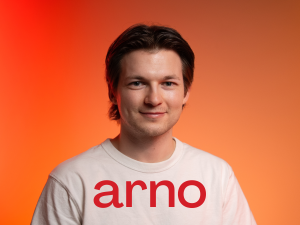‟ You can be as technologically skilled as possible, but if you can’t share your thoughts with other researchers or explain your work to a general audience, it’s very hard to get your ideas out there.”
Meet Arno Geimer: from Luxembourg to Geneva and back, his academic path has been shaped by international collaboration, just like his groundbreaking research. Now a PhD student at SnT, he’s pioneering collaborative machine learning — enabling financial institutions to jointly train fraud detection models without sharing sensitive data. Arno’s work tackles one of today’s most pressing challenges: how institutions can harness collective intelligence while respecting privacy regulations like GDPR.
Relive the conversation—transcript below!
Tell us about your background and how you ended up at SnT.
I’m from Luxembourg and have been here most of my life. After high school I went to Germany to study computer science but quickly discovered I didn’t like it as much as I thought I would. I came back and did a bachelor in math at the University of Luxembourg, including an Erasmus semester in Strasbourg. Then I went to Geneva for my master’s in mathematics and computer science. Two and a half years ago, I joined SnT to start my PhD in computer science.
What drew you to research?
I’ve always been interested in computer science and programming. When the opportunity came up to study it formally, I followed through and eventually moved into research. I think my teenage self would be quite happy with what I’m doing.
How would you describe your research in simple terms?
I work on collaborative machine learning, which allows different entities to build common machine learning models on their own premises. For example, hospitals that can’t share patient data due to regulations can still train breast cancer detection models together. With GDPR and other privacy laws, it’s difficult for businesses to share data, so we’re finding ways to let them collaborate while keeping their data secure.
What’s been your biggest research challenge?
It took time and commitment, but I eventually found my focus in collaborative machine learning.
‟ The biggest challenge has been identifying something that’s exciting to me and hasn’t been studied extensively. ”
What made you feel welcome when you joined SnT?
When I joined SnT, it was in July, so everybody was on holiday and there weren’t many people in the office. This actually allowed me time and space to talk to people and get to know them. We had Friday breakfast meetings where we would just hang out – five to ten people – just to discuss and exchange on all sorts of topics and have fun, and that really helped me integrate into our group.
What’s the reality of being a researcher versus people’s assumptions?
Many people assume researchers sit all day in their lab in front of computers. But we also go to conferences to learn new methods, discuss our projects, and share our research results!
What skill do you think is most underrated in tech research?
Communication. People won’t listen if you can’t communicate effectively. Government can also help by promoting these stories and showing that tech research is collaborative; it’s not just researchers stuck alone in rooms all day.
‟ You can be as technologically skilled as possible, but if you cannot share your thoughts with other researchers or explain your work to a general audience, it’s very hard to get your ideas out there. ”
How do you see progress in encouraging women and girls to enter ICT?
I think we’re getting there through representation. When people see others like themselves succeeding in these fields, it’s encouraging. For example, big companies such as Open AI have high-ranking woman executives. I also recently attended a conference where a keynote speaker was a woman from Portugal with a brilliant career. And I think that helps, showing girls and women that they can succeed in these fields and that they should enter them if they want to.
What does tech research need more of?
Tech research needs more permanent positions for postdocs and other researchers.
Supported by the Luxembourg National Research Fund.
